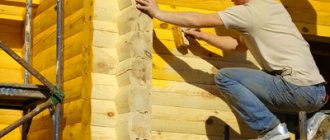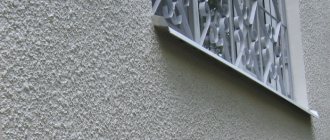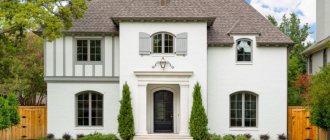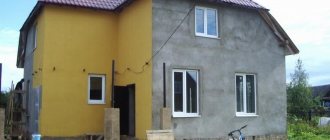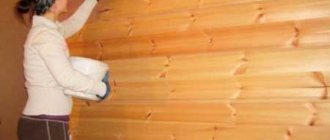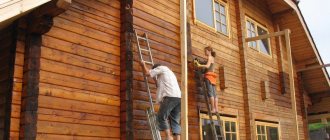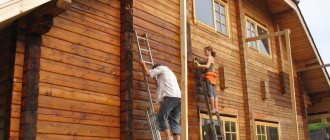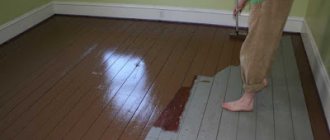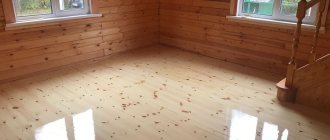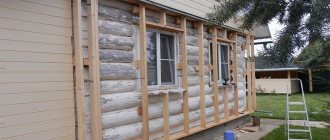Of primary importance when building a wooden house is the quality of the wood used. The choice of wood for building a house should be approached very carefully. Properly selected and applied in accordance with the manufacturer’s recommendations, facade paints, antiseptics, and wood glazes will effectively protect a wooden house from precipitation and UV, and keep it in excellent condition for many years.
Now it’s the 21st century and wood as a construction material is experiencing another surge in popularity. The craving for naturalness and natural materials is understandable. But it is not enough to build a wooden house or cottage, you need to provide them with proper care, and in order for the wood to last a long time and not lose its attractiveness, the house needs to be painted. When builders guarantee that a wooden building will last a hundred years, they mean its timely and correct protection from destruction.
Harmoniously selected color when painting a house
Why you need to protect a tree
Professional builders recommend painting a wooden house right away so that it lasts longer. Unprotected wood is negatively affected by almost all environmental factors. If a living tree is covered with bark, then only painting will protect the logs or boards.
- Exposed wood is destroyed by exposure to the sun's rays. Ultraviolet radiation affects lignin, a substance responsible for the lignification of plant cells. As a result, the wood darkens, becomes loose and damp. A fundamental change in the material occurs after six months of being in the open air. Since painting a wooden house over a damaged surface layer will not bring the desired result, you must first sand the surface to an undamaged material.
The logs of the log house dry out and crack over time.
Under the influence of ultraviolet radiation and temperature changes, the boards darkened and cracked
The cracked end of a log
- The alternation of rain and dry weather causes the wood to periodically swell and dry out unevenly. The result of the process is cracks of varying depths, which gradually increase. The house becomes unsightly and its ability to retain heat decreases. In addition, mold fungi settle in the cracks and rotting begins.
- Temperature changes in winter lead to moisture entering the pores of the wood during the thaw and then freezing. Ice crystals can tear wood fibers, forming cracks in the depths. Repeated repetition threatens that cracks will spread not only on the surface, but throughout the entire thickness of the frame.
Exterior painting of a wooden house creates a protective layer that serves as a barrier to negative impacts.
Correct selection of colors
The colors on the facade of the house play an important role in the appearance of the entire building. How to choose the right shades and tones so that the resulting composition “sounds” in a special way? To do this, you can use the following tips:
Peach tone Source landshaftdizajn.ru
- Tip #1: Attending a Home Show
In many cities, modern exhibitions of houses are organized, where ready-made examples of buildings made in various stylistic solutions are displayed. Here you can not only correctly select the desired shades, but also get acquainted with the varieties of materials used, offered by manufacturers.
Traditional design Source remoo.ru
- Tip #2: Working with online services and special programs.
If you can’t visit a modern exhibition of buildings, then you can resort to assembling shades yourself by working in special programs located on numerous online services. Here you can not only choose the main shade of the building’s facade, but also organically match it to the tone of the roof, doors and windows.
Good choice of color for a private home Source landshaftadvice.ru
- Tip #3: Test paint.
To finally decide on the tone of the facade, you should paint a small section of the wall in the color you like and see how it will look at different times of the day. It is advisable to observe the painted area in different weather conditions, then you will definitely be able to choose the color of the facade for your favorite home!
The entire range of available shades in which you can “dress” a house is conventionally divided into the following categories:
- Dark colors.
Such tones look organically on buildings made in simple architectural forms. It is not advisable to paint a house located on the sunny side in a dark color, as the bright sun will quickly fade the shade.
Modern house Source noviydom.com.ua
Types of paints
The abundance of modern paints and varnishes provides various options for solving the problem of how to paint the outside of a wooden house. All types of exterior or facade paint are divided into:
- glazing, i.e. translucent, preserving the appearance and texture of wood, possessing antiseptic properties;
- covering paints are oil, acrylic and alkyd paints that form an additional layer on top of the wood.
Types of paints and their differences in composition
Materials differ in composition, drying speed, appearance and other characteristics. Experts have not come to a clear conclusion about which paint is best to paint the outside of wooden houses, so you need to choose taking into account the wood from which the house is built (dry, damp, treated, old, etc.) and the climatic features of the area.
When choosing high-quality products, the preservation of wood is ensured for up to 15 years. Such a long-lasting and reliable effect can only be achieved by following the rules of painting and preliminary preparation.
Additional work
Before painting the outside of a country house, at the customer’s request, we perform a number of additional works:
- Cleaning walls from efflorescence. Removing efflorescence and cement mortar from brick and stone walls.
- Repair of brickwork and plaster. Restoration of seams and repair of cracks in brickwork, restoration of fragments of peeling or collapsed plaster.
- Plastering facades. Installation of reinforcing mesh, application of a plaster layer along the beacons, finishing of window slopes.
- Major/cosmetic/current repairs of facades. Tapping the plaster layer, eliminating blistering areas, jointing and filling cracks and other work.
After painting the dacha, we recommend waterproofing the facades by applying a moisture-resistant, vapor-permeable layer to protect the walls of the building from precipitation and prevent the formation of salts (efflorescence).
Wood pre-treatment
In order for the paint to apply smoothly, absorb well and last a long time, you need to prepare the surface for painting. Before treating the outside of a wooden house with any compound, antiseptic or fireproof, it is necessary to level the surface and seal the cracks.
After finishing the construction of the house, it is necessary to seal the joints and putty the cracks
The main condition is that the wood must be dry with a moisture level of no more than 20%, so preparation begins in the dry and warm season. If you put paint on a wet surface, the internal moisture will evaporate and destroy the coating and tear it away from the base.
The dry surface is cleaned of dust and dirt. If stains and stains of resin are difficult to remove, you can use a solvent. It is advisable to sand wood that was previously exposed to the open air mechanically.
After sanding, painting is carried out within 48 hours to ensure that the maximum effect of sanding is preserved.
First, the surface is treated with antiseptic primers or wood impregnations. Sometimes builders take on this work, but they often use the cheapest compounds - not very effective for preserving wood and environmentally unsafe. It is recommended to use water-based antiseptics that protect against the formation of mold, mildew and other biological formations on wood.
Antiseptics for wood
The application of antiseptics is carried out in strict accordance with the instructions indicated on the packaging. You cannot process at subzero temperatures, even if manufacturers offer winter antiseptics.
Requirements for paints for wooden facades
There are paints for interior and exterior use. Paintwork materials for external use have a wider temperature range of use and are more moisture resistant. Compositions for painting interior spaces must be safe for people and pets, have no unpleasant odors, and be highly resistant to abrasion.
Initially, the facade of a wooden house was painted with paints for exterior use. When decorating facades by painting became popular, paint manufacturers often began to write “façade” on the packaging instead of “exterior.” Over time, the second name stuck and began to be used even more often than the original one.
Paint “Facade” and “For external use” are the same thing Source karaokerox.ru
The following requirements apply to facade paints for wooden houses:
- High adhesive properties to wooden surfaces.
- Increased impact resistance and resistance to scratching and chipping, ensuring mechanical strength of the coating. The presence of increased mechanical wear resistance and resistance to abrasive wear from exposure to wind and dust.
- Weather resistance, which consists in the ability of a paintwork coating to resist the destructive effects of bad weather and the environment. Here we can also add the requirement for the chemical inertness of paintwork materials in relation to alkalis and acids formed in areas with high concentrations of exhaust gases.
- Hydrophobicity, providing water-repellent properties to protect wood from rotting.
- Resistance to sudden temperature changes of a cyclic nature.
- Lightfastness (resistance to ultraviolet radiation).
- Good vapor permeability.
- Preservation of elasticity after drying, compensating for microdeformations of facade materials during temperature changes.
- Low dirt retention, resistance to repeated washing.
- The ability to maintain the brightness of the color for a long time.
The better to paint
Paint for the facade of a wooden house can be translucent, glossy or matte. Since the natural look of wood is most attractive, glazing facade materials, which are available in the form of antiseptics, glazes or oils, are very popular.
The peculiarity of these materials is that they do not hide the structure of the wood. The materials work as impregnations, penetrate deep and create a barrier to getting wet or exposed to ultraviolet rays (UV). Despite their transparency, glaze paints are available in a wide range of colors. The most famous manufacturers:
- Renocoll (Rhenocoll) Germany.
- Teknos Finland.
If there is a desire to hide the surface of the wood, then use façade covering paints, which are divided into:
- oil - made from oils of natural origin and organic solvents;
- alkyd - produced in organic solvents or aqueous solutions of alkyds;
- acrylate (acrylic) coatings - based on acrylic and copolymers (latex, vinyl, silicone).
These paints form an opaque protective film that completely hides the wood grain. Over time, they oxidize, cease to be elastic and crack. Subsequently, the top layer turns into a powdery white substance (paint chalking process). After a few years, the layer will need to be removed completely or partially and the work done again.
Acrylic paints are more expensive and have a high degree of elasticity.
Well-known manufacturers of covering paints:
- Tikkurila (Finland).
- Alpina (Germany).
- Dufa (Germany).
- Beckers (Sweden).
- Dulux (Netherlands).
- Marshall (Türkiye).
Facade acrylic paint Dulux
Tikkurila paints are well known among us
Impregnation for the protection of wooden surfaces from Dufa
Among the Russian brands, the most popular are “Optimist”, “Svyatozar”, “Tex”, “Yaroslavskie Krasny”.
Average paint service life:
- glazing antiseptics - 5 years;
- acrylic - 8-10 years;
- oil - up to 6 years;
- alkyd materials - 7 years.
When comparing different types of paint, consider their pros and cons:
- oil paints - have a high penetrating ability, reliably protect against moisture, but dry slowly (several days depending on the temperature), which is sometimes unacceptable for outdoor work;
- alkyd compositions - have good frost resistance, but crack over time under the influence of UV;
- acrylic - convenient and easy to use, odorless, do not lose color, a new shade is easily obtained by mixing white paint with colorants (colored dyes), but if the house is painted with acrylic paint, then in the future you can only use them.
In recent years, acrylic paints and varnishes have taken a leading place, despite their higher price. Considering how much it costs to paint a wooden house and what effort it requires, it is not advisable to focus on cheap types. It’s better to do it well once than in 2-3 years the house will look sloppy. Immediately choose how to paint the outside of a private house or cottage for a long time, even if you have to invest more.
The total cost of painting depends mainly on the size of the house. This amount will include the cost of antiseptic, putty and paint.
Photos of painted wooden houses from the outside
A wooden facade is one of the oldest methods of finishing the exterior of a house. The popularity of this solution continues unabated; a fashionable solution today is to make part of the façade from this material. Despite all the advantages of the method, natural material requires constant and careful maintenance. Impregnation and painting of boards with special products is necessary to protect them and improve their appearance. Consider effective solutions that will produce the desired results.
Which color to choose
The choice of color depends only on the wishes of the homeowner. Manufacturers offer a wide range of shades. Typically, preferences depend on the design of the house and the location where it is located. To make the house visually blend with its environment, various shades of green, sand, and brown are chosen.
There are no restrictions on the choice of color, the main thing is aesthetics
To highlight a building in the area, you can use bright white, blue, and yellow. The most effective is the combination of two colors - light and dark.
A significant part of developers are more focused on the practical effect of painting, for example, dark colors attract rays, the surface heats up too much and cracks form on the wood. Light shades reflect light and do not fade longer, but dirt is more visible on them. The light gray color fades the least.
If resin appears on the wood, they prefer light dyes so that the wood does not heat up. Resin secretions are less noticeable against a background of cream, white, or ivory.
Often, paint is chosen to match or contrast with the color of the roofing material.
What can color depend on?
Ideally, the look of your home, both inside and out, should match your personality, preferences and tastes. But it turns out that this is not the only thing that determines the color of the facade.
“The appearance of the façade of a house most often determines the style of its interior; for example, a Victorian-style interior suggests the same design on the outside. It’s another matter when a house or townhouse is located in a cottage community, in which case the developer sets the exterior style, and the house owners have no choice but to adhere to it.
As for the choice of color, designers have the concepts of “feminine”, “masculine” or “neutral” interior, and the same applies to exteriors. So, a young married couple would rather try to choose something light and light. Very often the choice is influenced by memories associated with a joint vacation: they settle on the colors blue, white, sand. Women prefer red and pink, velvety surfaces, and elegant decorative elements. Men traditionally choose brown and dark tones, a brutal look for the facade of the house. A designer I know recently built himself a house from timber: all the wood is light, with black window frames, black flooring inside, red and black furniture. If there is a choice, the color of the house will definitely reflect the character, preferences and even gender of the people living in it,” says Alisa Semenova, designer of the interior studio LOFT&HOME.
Sequence of painting work
To properly paint a wooden house, you need to follow the technology and sequence of actions. Painting a frame house follows the same rules as a log house.
- First of all, the surface is cleaned of dust, construction debris, and resin stains - otherwise, mixed with the paint, foreign particles will remain on the facade. If this is not the first treatment of the building, then carefully remove the previous paint and clean the surface down to wood.
- Then mechanical grinding of the surface is carried out manually or using a grinding machine. Sanding and further painting are carried out with a short break, no more than 3 days, so that the cleaned base does not have time to suffer from external factors.
- In an old house, cracks, unevenness and damaged areas are puttied. If nails or other metal elements protrude from wood, they are coated with a special primer designed for metal.
- After this, the entire surface is covered with a primer with antiseptic properties and impregnations. The primer will not only perform protective functions - after its application, paint consumption will noticeably decrease and it will apply more evenly.
- Then they move directly to painting. The paint is applied with a roller or sprayed with a spray gun. It is necessary to take into account that acrylic facade coatings are too thick and viscous - only a professional tool is suitable for them. To use household sprayers, the paint will have to be thinned, which means the layer will be thinner than what the manufacturers recommend.
- Painting is done in several layers. Each subsequent layer is applied only after the previous one has completely dried. When painting with a roller or brush, apply the paint along the grain of the wood.
Advantages of painting your dacha by specialists:
- Many years of experience in performing facade work using industrial climbing methods.
- Strict adherence to deadlines for painting a country house, responsible approach, efficiency and quality.
- Certified high-altitude professionals with the skills of highly qualified painters, plasterers, and repairmen.
- Application of proven technological schemes, modern and high-quality consumables.
- A flexible and transparent pricing policy that allows the client to know exactly how much it costs to paint a country house at the stage of drawing up a contract.
- Using lifting equipment, scaffolding or industrial mountaineering methods - selecting a method so that painting the facade of a country house - price and timing - completely suits the client.
- Guarantee for completed painting of the facade of a country house.
So that our clients know how much it will cost them to paint their dacha, we have summarized the prices for individual types of work in a table.
| № | Name of works | Unit change | Price, rubles |
| 1. | installation, dismantling of tour towers (if necessary) | sq.m. | 100 |
| 2. | façade sanding (removing old paint) | sq.m. | 200 |
| 3. | facade painting (1 layer) | sq.m. | 250 |
| 4. | painting window frames | mu.pog. | 285 |
* Prices are for work, excluding materials.
When ordering services for painting a country house in, you should keep in mind that the cost of painting a country house does not include payment for consumables: putty, primers, paint, etc. If you want to update your country house - painting the country house by craftsmen will cost you a budget amount - call us at tel.
How to paint an old wooden house correctly
You can only paint dry wood, otherwise the paint will curl.
Painting is best done in cloudy but not rainy weather. This is due to the fact that direct sunlight, when hitting a painted surface, contributes to the formation of stains. Before applying the paint, it must be mixed thoroughly. For painting, it is better to choose a wide brush with natural or mixed bristles and dense padding. Work begins with the lower crowns of the frame, applying paint only in a horizontal direction to avoid smudges. To get an even and beautiful coating, you need to apply two or three layers. After repainting the house for the first time, you need to wait for the paint to dry completely, and only then proceed to the next layer.
paints and varnishes
0 votes
+
Vote for!
—
Vote against!
The appearance of any building is the main element that determines the overall impression of it. Therefore, special attention should be paid to the decoration of the facade. The simplest and most affordable option is to paint it. The paint can be tinted in any color or shade, and if necessary, repainting the facade is quite simple. Let's look at how to paint the outside of a house yourself below.
Table of contents:
- Painting the outside of the house: the advantages of this type of finishing
- Painting a wooden house outside photo and technology
- Painting the outside of the house photos and recommendations
- Options for painting the outside of a house: recommendations for choosing colors
- Choosing paint for painting the outside of a house
Painting the outside of the house: the advantages of this type of finishing
The choice of paint as a finishing material for walls has many advantages. Among them we note:
- lightness and availability of materials;
- wide range of colors;
- a variety of paints in composition, texture, method and place of application;
- resistance to temperature changes;
- resistance to moisture and ultraviolet radiation;
- ensuring the protection of the building from external irritants.
However, in order for the paint to serve you for a long time, you should follow certain technological recommendations for its application. It is prohibited to paint facade walls in frosty weather, in the presence of strong wind or rain.
Painting a wooden house outside photo and technology
Wood is a living material that ages over time, so to protect it, it should be coated with various types of compounds, including paints and varnishes. Wood is affected by high humidity, temperature changes, and frost; under their influence, the tree becomes coarser, becomes covered with mold, mildew, and deteriorates. Paint forms a thin film on the surface of the wood that protects it from these factors.
Before painting, the wood must be treated with antiseptic materials to protect it from biological factors. The lifespan of the painted surface depends on the correct preparation of wood for painting.
First of all, the wood is washed with water, which cleans it of dust. Next, the walls of the house are examined for the presence of fungus or mold. To process them, special chemicals are used, and then water. If there is resin on the tree knots, it is also removed.
To treat all metal parts on wooden walls, it is necessary to use an anti-corrosion primer. After completing these steps, the tree is left for 10-14 days until completely dry. If there is high humidity outside, this time increases. At the same time, you can pre-coat the wood with a primer, which provides additional protection.
The paint for painting the outside of a wooden house must also be chosen correctly. Antiseptic compounds penetrate several millimeters into the wood structure, thereby providing deep protection. Antiseptics are coating, translucent or glaze. Using the latter option, it is possible to give the wood a certain shade, while maintaining its texture and naturalness. With the help of opaque antiseptic compounds, it is possible to preserve the wood texture, but they completely paint over the color.
Among the coating compositions for painting the outside of a wooden house, we note:
- oil-based paints - are well absorbed into the wood, provide its protection from external irritants, prevent moisture from entering the wood, however, such paint will take several days to dry, in addition, after a certain time has passed after their application, the color may change;
- Acrylate-type paints are highly resistant to weather conditions, have a beautiful color after application, have an excellent shine and are not prone to cracking.
Painting the outside of a timber house is done using any of these compounds. However, they all differ in service life, glaze compositions are renewed once every 4-5 years, oil paints last several years longer, and acrylate paints do not need updating for ten years.
Most wood paint manufacturers recommend carrying out the painting process in stages. Initially, it is necessary to apply a primer antiseptic, which will protect the wood from moisture. If you do not use this advice, the life of the tree will be significantly reduced.
Recommendations for applying paint to wooden surfaces:
1. While working, periodically stir the paint thoroughly to obtain a more uniform color. Before you start painting the wall, paint the workpiece and look at the quality of the color.
2. Use a brush to apply paint, as a roller is not able to provide the necessary quality in painting.
3. If possible, tint the primer, which is previously applied to the surface of the wood to match the color of the paint, to achieve greater color depth.
4. It is necessary to work under certain conditions. Too high a temperature and direct sunlight will cause paint to dry faster. Thus, it worsens its characteristics. It is best to carry out work in dry, calm and cloudy weather.
5. Application of the antiseptic composition is carried out exclusively longitudinally. The ends should be carefully painted, since this is where moisture accumulates.
Painting the outside of the house photos and recommendations
There are several options for painting the outside of a house. It all depends on the general condition of the walls of the house. Since it is possible to paint only the constructed walls or the facade, which was previously painted.
We suggest considering the second option. After the paint has become unusable and begins to crumble and peel, fungus begins to develop on the wall. Since paint does not protect the surface from moisture. In this case, to update the surface, you should use new paint.
If there are small problems in certain areas, then it is enough to correct only them. However, it is necessary to use the same type of paint that was previously used. To determine the type of paint on the wall of the house, you should carry out a visual inspection.
If the paint is cracking along the wood grain, it should be assumed that an acrylate version of the paint was used. In case of lateral or checkered cracking of paint, oil-based paint was most often used. If you take a small piece of paint and try to roll it, oil paint will collapse, but acrylate paint will curl, since it is highly elastic.
If there is an antiseptic composition on a wooden house, then to improve its attractiveness, you should also apply only an antiseptic, although if you wish, you can cover the facade with paint. If the antiseptic is severely worn, it is better to cover the surface with acrylate paint.
If the wood surface has previously been painted with oil-based paint, the paint should be completely removed from the surface by stripping before painting. If this is not done, the new coat of paint will not last long. The surface to be painted should be cleaned not only of paint, but also of dirt and dust. This is done in order to increase the adhesion of the new paint to the wood.
In order to improve the adhesion of paint to the wall, you should pre-treat the wall with water and an alkaline detergent. If there are rotten or cracked boards, they must be replaced. If the paint cannot be removed by cleaning, then use special chemical compounds. After cleaning the wood, it is recommended to sand it.
Options for painting the outside of a house: recommendations for choosing colors
Choosing the right color for your home determines the overall impression of it. In the process of selecting colors, you should be guided primarily by the general style and design of the exterior, as well as individual preferences.
Look around, examine the nearby territory and landscape. For your home, you should choose natural and unsaturated colors in the form of white, gray, beige, brown, blue, green or red. Color can be used to highlight or hide a building. So, for example, if your site is dominated by plants and trees, then it is not advisable to paint the house green, as it will blend in with the overall exterior. The red color makes it stand out against the background of green plants and blue sky.
In addition, one should take into account the harmony in the combination of the color of the roof and the facade; they should not be painted in the same color, but it is advisable that they be painted in derivative shades.
The color for the facade is selected according to the following principles:
- the house should stand out from the surrounding objects;
- the main building must be separated from other buildings;
- try to paint the facade in calm tones, and highlight certain elements in the form of window and door openings, balconies with bright accents;
- the colors of the facade, roof and other landscape elements must be combined with each other.
Options for painting the outside of a house photo:
The choice of white as the main color for the facade gives it sophistication, elegance, and solemnity. This façade is filled with positivity, warmth and joy. In addition, white color goes with all colors, so it is ideal for any interior. The white building looks very beautiful against the backdrop of greenery and trees.
Associations of gray color are associated with a foggy mood, dew and clouds. This facade looks boring. Therefore, this color is rarely used to paint the walls of a house.
The choice of brown as the basis for the facade of the house speaks of spaciousness, modesty, but at the same time confidence. However, when choosing this color as a facade, you should take into account the color of the roof, which should be gray, dark brown or red.
A very attractive option is to choose yellow for painting the facade. This color is distinguished by associations with freshness, sun, warmth, so it easily lifts your spirits.
If there are practically no trees on the territory of the house, then you can choose the green color of the walls. When painting the outside of a house, colors should be selected taking into account their compatibility with each other.
So, the roof and facade should be harmoniously combined with each other. If the facade colors are bright, for example yellow, green or blue, then the roof should be a neutral color, white, gray or beige.
In addition, when choosing the color of the facade, you should take into account the shadow that falls on it during the day. If there are large trees on the site, then it is better to choose a matte version of the paint; otherwise, you can use a glossy one.
When choosing a yellow façade color, try to select a roof that is a derivative color, for example green. We invite you to familiarize yourself with the most popular color combinations for the facade of a house:
- painting the roof a dark color and the walls a light color is a good option, which is quite common in most facades;
- the roof and walls are painted in different tones of the same color, in this case it is possible to obtain a harmonious, monolithic structure, however, its appearance will be a little boring, therefore, in order to diversify such a facade, certain elements should be highlighted with bright colors;
- bold individuals or innovators prefer to paint the walls in dark colors and the roof in light colors, thus achieving the effect of the house dissolving into the sky.
In addition, you should pay attention to the general style of the interior. Thus, for the classical style it is uncharacteristic to use bright and rich tones; for the Provence style it is better to use white, yellow and blue colors.
Choosing paint for painting the outside of a house
The lifespan of paint depends primarily on its composition. In relation to this indicator, paints come in two types:
1. Paints with an organic base. After their application, a dense film is formed, which is vapor-tight. These paint options are toxic and fire hazardous. However, among their advantages we note long service life, resistance to atmospheric influences, and the possibility of use at sub-zero temperatures.
2. Water-based paints are environmentally friendly, non-flammable substances, have a polymer or mineral base. Their service life is slightly shorter, since the paints are water-soluble.
We invite you to familiarize yourself with the main types of facade paints based on water dispersion:
- vinyl paints - affordable, but easily washed off with water;
- paints of acrylate origin are more resistant to moisture, flexible and have a high level of adhesion;
- Silicone paints contain silicone resins, provide reliable protection of the wall from moisture, and are easy to clean.
Please note that both water and organic types of solvents are used to dilute these paint options.
Water-based mineral paints are divided into:
- lime-based paints are cheap, durable, short-lived, and are rarely used for painting facades;
- silicate paints contain elements of liquid glass, adhere well to the surface, are resistant to moisture and are fireproof;
- Cement-based paints are short-lived, affordable, but vapor-permeable.
The choice of a particular paint option should be based primarily on the type of coating to which it will be applied. In addition, you should take into account the individual characteristics of the building, the material abilities of its owners and the desired result of painting.
Generalization on the topic
To summarize, we can safely say: when choosing the type of paint, it is important to remember that paint compositions should emphasize the natural beauty of the wood, and not cover the color of natural wood. Water-dispersion paints (acrylic compositions) are best suited for interior surfaces. More detailed information about the composition is revealed by the paint labeling. It indicates the spreadability of the composition, compliance with certain climatic conditions, and the presence of additional (antiseptic, antifungal) additives. After painting, wooden walls and ceilings do not require any special care. They tolerate wet cleaning using non-abrasive household chemicals.
vote
Article rating
What is the best tool to paint exterior walls?
Wooden buildings are painted with a brush, roller, or spray gun. It is more difficult and longer to work with a brush, but with its help you can paint all surface joints more efficiently. The paint is applied faster with a roller, but it does not paint the inter-crown ends and also leads to the formation of smudges. The spray gun applies the product as evenly as possible, but overlaps of paint layers are possible.
Photo: brush, roller and spray gun
That is, the best tool for painting a house is still a brush.
Mistakes when doing work independently
A typical mistake when painting an old wooden structure is poor quality and improper preparation of the wood before applying the dye. Some unprofessional builders, wanting to quickly and cheaply repaint an old log house, perform only part of the necessary preparatory work, or even skip the preparation stage, which ultimately only increases costs. For example, when painting yourself, logs are often not sanded, as a result of which the antiseptic cannot penetrate deeply into the wood, which causes the fragility of the new coating.
When painting, it is very important to use the right tool and the appropriate paint composition, as well as strictly follow the paint application technology. It must be taken into account that the antiseptic used must be combined with the coloring composition. If the dye and primer are selected incorrectly, it is impossible to obtain the desired effect; in addition, such a coating will not last long.
General tips and tricks
When painting the exterior wooden surfaces of a residential building, it is recommended to “listen” to some advice from experienced craftsmen.
- The paint is applied only to a dry surface. When painting in several layers, the interlayer exposure is observed, which for alkyd compositions is 24 hours, and for water-based ones - from 2 to 12 hours.
- Paintwork materials are applied in the longitudinal direction relative to the fibers.
- The consumption of façade paint will be noticeably reduced if the surface is primed.
Exterior painting of a log bathhouse
A bathhouse is a building with specific operating conditions; the interior of the log house is exposed to high humidity and temperature. Therefore, the main condition for the external coating is to maintain the vapor permeability of the walls. Otherwise, moisture will linger in the wood for a long time, creating a favorable environment for the development of mold microorganisms. When thinking about how to paint the exterior of a log bathhouse, do not forget about the nuances of processing the loghouse of a bathhouse:
- Logs must be dry and clean .
- In order for the protective layer of the new log house to serve as reliable protection, the lumber is treated with stain before collecting the crowns .
- Before repainting, the structure must be cool and ventilated .
Stages of processing and painting a bath Source do.59.ru
Impregnations are conveniently applied in the following sequence:
- Antiseptic . Products based on natural and synthetic oils are optimal.
- Fire retardant.
- Dye . The best option is acrylic facade paints, non-toxic, durable and vapor-permeable.
Preparing the house for painting
The first step is to inspect the entire structure.
If the inspection reveals logs that are rotten and severely damaged by fungus, they will have to be replaced. If the wood has not yet been damaged, areas covered with mold can be preserved. In this case, moldy areas are treated with an antiseptic. A darkened surface can be bleached using special bleaching compounds. For the same purposes, ordinary cheap white is suitable, which will provide the same effect as more expensive special means. Large and small cracks are sealed with acrylic-based putties for exterior use. If the surface is to be painted in the future, putty of any color is suitable; under the varnish coating it is better to use products that match the wood.
Main stages of preparatory work:
- Old peeling paint is cleaned off with a wire brush or spatula. You can also use chemicals designed to clean the surface. The mechanical method is faster, and the chemical method takes longer, but is more effective. After chemical treatment, the old log structure will look like new.
- Uneven and rough surfaces are sanded to good light wood. To do this, use a grinder with a special attachment. If there are any unevenness left on the wood after sanding, they are smoothed out with coarse sandpaper.
- Next, a primer is applied. To protect wood from the appearance of fungus and mold, it is better to paint it with a primer composition with antiseptic additives. It is advisable to use a primer that matches the color of the paint that will be used to paint the house.
Painting the outside of a log house: factors affecting quality
The quality of painting a wooden country house depends mainly on two factors:
- Weather . Ideal weather is dry and windless. Do not paint in the sun (the paint will dry too quickly and unevenly), during or after rain. The permissible temperature is determined by the type of paint (indicated on the label).
- Wood moisture content . It should not exceed 20% during painting, so façade walls made of wood with natural humidity are painted after the frame has shrunk.
A necessary condition for a quality result is ease of use Source projecty-domov.ru
How to prepare a surface for painting
Before you start working with decorative antiseptic or paint, you need to make sure that the structure of the house itself will not become a source of serious problems for the wood; that complete structural protection has been created (ebbs, slopes, etc.), there are no roof leaks, all pipelines are in working order, the vapor barrier is correctly designed and installed correctly. Problems may be due to the absence or improper installation of a drain, exposure to ground moisture from the foundation, leaking expansion joints at the joints of moving structural elements, etc. – all this needs to be eliminated as much as possible.
Then you need to properly prepare the surface of the wood; the durability of the coating depends on this. All the homeowners who proudly display photographs of facades on FORUMHOUSE with the comments “painted seven years ago, looks like new” did this before painting:
- We chose high-quality wood for construction;
- Repaired damaged areas: eliminated cracks, rot, hail holes, mold, etc.;
- Provided structural protection of the façade;
- We performed sanding, which removes the weathered layer, opens the pores, and creates a surface ideal for adhesion of the finishing protection. After sanding, the facade was blown with compressed air to remove dust and adjacent surfaces and objects were protected from paint splashes with films and masking tape;
- The surface was primed with a specialized primer for wood. Good soil protects against the risk of fungi, insects, mosses and algae. Particularly advanced primers combine penetrating properties (up to several millimeters) with the ability to block stains of dyes onto the surface of the finish coat.
- We used breathable protective materials that were favorable for the release of water vapor from painted wood.
